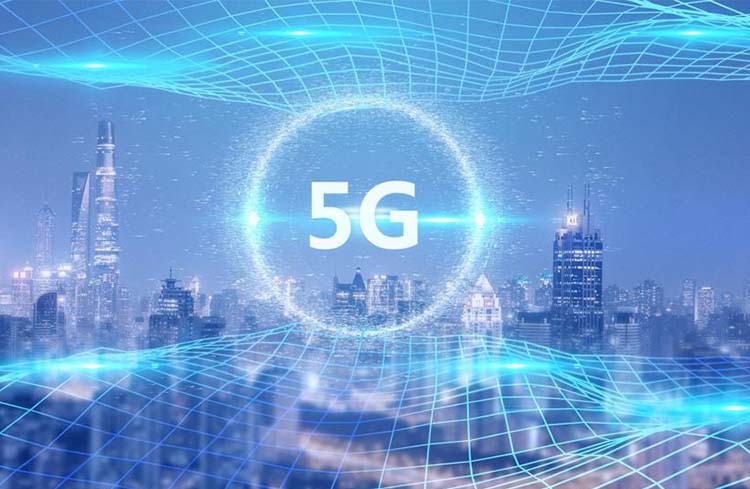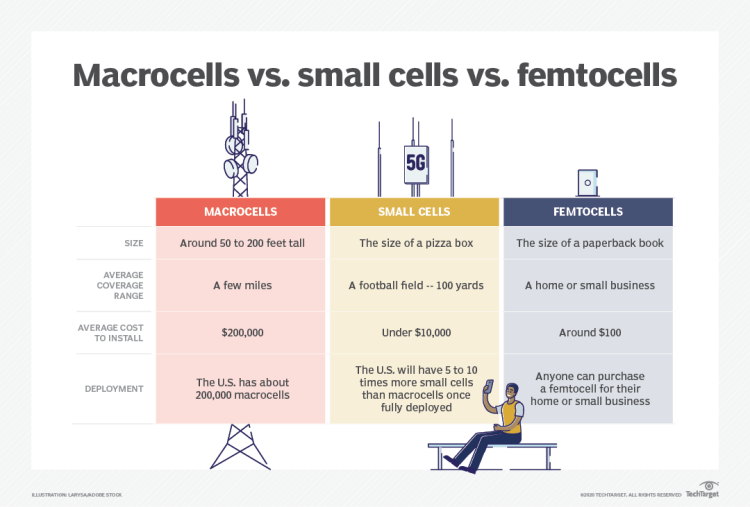
Small cell technology has been touted as a major new development with 5G networks, but small cells aren't the only base stations that will provide 5G connectivity. 5G networks will also use macrocells — such as cell towers — for connectivity, and these larger base stations will enable lower 5G frequencies, compared to small cell's high-frequency millimeter wave (MM wave) capabilities. Carriers will also provide 5G femtocells for better in-home or SMB cellular coverage. The differences among macrocells vs. small cells vs. femtocells are apparent in size, coverage and cost, but definitive plans for overall 5G coverage are still unknown.
Defining macrocell, small cell and femtocell
Macrocell. A macrocell is a cellular base station that sends and receives radio signals through large towers and antennas. Cell towers, in particular, can range anywhere from 50 to 200 feet tall and provide cellular coverage for miles.
Small cell. A small cell is another type of cellular base station that is physically small — around the size of a pizza box — and transmits radio signals. The goal of small cells is to boost wireless network connectivity in specific areas, as small cells can enable MM wave frequencies with high-speed broadband connectivity.
Femtocell. A femtocell is a wireless access point used to enhance indoor cellular connectivity. Unlike other cellular connectivity options, femtocells connect back through the internet to provide in-home or office cellular connectivity. Femtocells look and operate like routers, and users can place femtocells near their current network hardware setups. Femtocells are accessible to anyone who wants to purchase one.

Image source: TechTarget
Macrocell vs. small cell technology
While both macrocells and small cells provide 5G connectivity, their signal propagation and building penetration capabilities differ greatly. Signal propagation — the coverage radius — is the key difference between macrocells vs. small cells: Macrocells provide low-frequency coverage for miles, while small cells provide high-frequency coverage for around 100 yards.
Building penetration refers to whether the connectivity will work indoors. Lower frequencies from macrocells travel far, and walls, windows or other physical barriers don't block the signals. On the other hand, small cell technology has line-of-sight limitations, which means physical barriers can block the signal so it can't reach multiple rooms indoors.
Another difference between macrocells vs. small cells is cost. Macrocells traditionally cost around $200,000 to set up, while small cells will cost under $10,000, according to Finneran. Even if carriers deploy 10 times the number of small cells compared to macrocells, the cost of small cells will still be significantly less than full macrocell deployments. Carriers can update existing macrocells to 5G as well, although this transition will take years.
Small cell vs. femtocell technology
Femtocells, picocells and microcells are often deemed as types of small cells because of their smaller size and limited coverage, but Finneran said that categorization isn't accurate. Picocells and microcells are commonly used in airplanes, hotels and malls, but they don't have consistent definitions across the wireless industry — although microcell is likely a former term for small cells, he said. Femtocells, however, preceded small cells and make up a separate market, due to two key differences.
Femtocells are also smaller than small cells — around the size of a paperback book, if not smaller, Finneran said — and don't have the line-of-sight restrictions that small cells have. If a user places a femtocell in a central location in a home or office, that person should get sufficient coverage. Also, as femtocells are private, only one person's devices can connect to the femtocell, whereas anyone can connect to small cells.
Small cell and femtocell use cases differ as well. For example, femtocells are to Wi-Fi routers as small cells are to Wi-Fi hotspots, meaning small cells can boost cellular coverage in areas where people congregate, such as stadiums, like a Wi-Fi hotspot for internet connectivity.
Expectations for small cell technology
While major differences among macrocells vs. small cells vs. femtocells are already known, 5G small cell technology is still nascent, so it's unclear how small cell technology will operate in practice. Finneran said he expects quirky problems with MM wave when carriers first deploy it, as this slice of spectrum is new to both the consumer and enterprise markets. With the line-of-sight restrictions and inability to travel long distances, MM wave will be a major adjustment for carriers and users alike.
Backhaul is also a major issue regarding small cell technology, and carriers have yet to develop an effective answer to this problem, Finneran said. This issue is especially pertinent if carriers plan to place small cells on objects such as lampposts, which are supported by electric power rather than the fiber links small cells will require.
While small cells appear to be beneficial hotspots for places such as stadiums or outdoor event centers, carriers have yet to reveal solid plans for wide-area small cell deployments. Yet, despite the shortcomings and the unknowns, small cells remain critical facets in 5G plans.
Source: https://www.techtarget.com/searchnetworking/feature/Macrocell-vs-small-cell-vs-femtocell-A-5G-introduction

